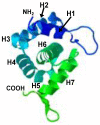Understanding the process of envelope glycoprotein incorporation into virions in simian and feline immunodeficiency viruses
- PMID: 24441862
- PMCID: PMC3917442
- DOI: 10.3390/v6010264
Understanding the process of envelope glycoprotein incorporation into virions in simian and feline immunodeficiency viruses
Abstract
The lentiviral envelope glycoproteins (Env) mediate virus entry by interacting with specific receptors present at the cell surface, thereby determining viral tropism and pathogenesis. Therefore, Env incorporation into the virions formed by assembly of the viral Gag polyprotein at the plasma membrane of the infected cells is a key step in the replication cycle of lentiviruses. Besides being useful models of human immunodeficiency virus (HIV) infections in humans and valuable tools for developing AIDS therapies and vaccines, simian and feline immunodeficiency viruses (SIV and FIV, respectively) are relevant animal retroviruses; the study of which provides important information on how lentiviral replication strategies have evolved. In this review, we discuss the molecular mechanisms underlying the incorporation of the SIV and FIV Env glycoproteins into viral particles.
Figures




Similar articles
-
Feline immunodeficiency virus envelope glycoproteins antagonize tetherin through a distinctive mechanism that requires virion incorporation.J Virol. 2014 Mar;88(6):3255-72. doi: 10.1128/JVI.03814-13. Epub 2014 Jan 3. J Virol. 2014. PMID: 24390322 Free PMC article.
-
Effect of the cytoplasmic domain of the simian immunodeficiency virus envelope protein on incorporation of heterologous envelope proteins and sensitivity to neutralization.J Virol. 2000 Sep;74(18):8219-25. doi: 10.1128/jvi.74.18.8219-8225.2000. J Virol. 2000. PMID: 10954518 Free PMC article.
-
In vitro binding of simian immunodeficiency virus matrix protein to the cytoplasmic domain of the envelope glycoprotein.Virology. 2008 May 10;374(2):273-9. doi: 10.1016/j.virol.2008.01.015. Epub 2008 Feb 5. Virology. 2008. PMID: 18255119
-
FIV Gag: virus assembly and host-cell interactions.Vet Immunol Immunopathol. 2010 Mar 15;134(1-2):3-13. doi: 10.1016/j.vetimm.2009.10.003. Epub 2009 Oct 14. Vet Immunol Immunopathol. 2010. PMID: 19910057 Free PMC article. Review.
-
Simian and feline immunodeficiency viruses: animal lentivirus models for evaluation of AIDS vaccines and antiviral agents.Antiviral Res. 1991 May;15(4):267-86. doi: 10.1016/0166-3542(91)90009-g. Antiviral Res. 1991. PMID: 1659310 Review.
Cited by
-
Review and Perspectives on the Structure-Function Relationships of the Gag Subunits of Feline Immunodeficiency Virus.Pathogens. 2021 Nov 18;10(11):1502. doi: 10.3390/pathogens10111502. Pathogens. 2021. PMID: 34832657 Free PMC article. Review.
-
Expression, purification, and functional characterization of soluble recombinant full-length simian immunodeficiency virus (SIV) Pr55Gag.Heliyon. 2023 Jan 10;9(1):e12892. doi: 10.1016/j.heliyon.2023.e12892. eCollection 2023 Jan. Heliyon. 2023. PMID: 36685375 Free PMC article.
-
A Replication-Competent HIV Clone Carrying GFP-Env Reveals Rapid Env Recycling at the HIV-1 T Cell Virological Synapse.Viruses. 2021 Dec 25;14(1):38. doi: 10.3390/v14010038. Viruses. 2021. PMID: 35062242 Free PMC article.
-
Properties and Functions of Feline Immunodeficiency Virus Gag Domains in Virion Assembly and Budding.Viruses. 2018 May 16;10(5):261. doi: 10.3390/v10050261. Viruses. 2018. PMID: 29772651 Free PMC article. Review.
-
Lentiviral Gag assembly analyzed through the functional characterization of chimeric simian immunodeficiency viruses expressing different domains of the feline immunodeficiency virus capsid protein.PLoS One. 2014 Dec 2;9(12):e114299. doi: 10.1371/journal.pone.0114299. eCollection 2014. PLoS One. 2014. PMID: 25462889 Free PMC article.
References
-
- Clements J.E., Wong-Staal F. Molecular biology of lentiviruses. Semin. Virol. 1992;3:137–146.
-
- Seelamgari A., Maddukuri A., Berro R., de la Fuente C., Kehn K., Deng L., Dadgar S., Bottazzi M.E., Ghedin E., Pumfery A., et al. Role of viral regulatory and accessory proteins in HIV-1 replication. Front. Biosci. 2004;9:2388–2413. - PubMed
Publication types
MeSH terms
Substances
LinkOut - more resources
Full Text Sources
Other Literature Sources

